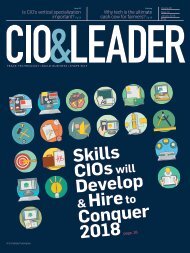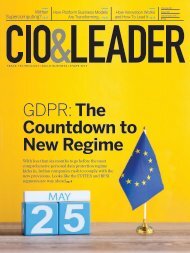white_paper_on_data_protection_in_india_171127_final_v2
You also want an ePaper? Increase the reach of your titles
YUMPU automatically turns print PDFs into web optimized ePapers that Google loves.
ENFORCEMENT TOOLS<br />
2.6 Introducti<strong>on</strong><br />
A number of regulatory tools and mechanisms may be simultaneously utilized to<br />
achieve different enforcement objectives. Some of these may be based <strong>on</strong> a coregulatory<br />
model whereas others may be based <strong>on</strong> a ‗command and c<strong>on</strong>trol‘ approach.<br />
These are discussed below.<br />
A. CODES OF PRACTICE<br />
2.7 Issues<br />
A code of practice or c<strong>on</strong>duct is c<strong>on</strong>sidered an important element <strong>in</strong> establish<strong>in</strong>g a workable<br />
co-regulatory <strong>data</strong> protecti<strong>on</strong> scheme. As has been discussed <strong>in</strong> Part IV, Chapter 1 of the<br />
White Paper, a co-regulatory framework is <strong>on</strong>e that <strong>in</strong>tegrates elements of self-regulati<strong>on</strong> with<br />
elements of governmental regulati<strong>on</strong>. Codes of c<strong>on</strong>duct orig<strong>in</strong>ate <strong>in</strong> ord<strong>in</strong>ary <strong>in</strong>dustry<br />
practices where associati<strong>on</strong>s engage <strong>in</strong> standard-sett<strong>in</strong>g for better service provisi<strong>on</strong> or<br />
manufactur<strong>in</strong>g. They thus naturally form part of some self-regulatory systems <strong>in</strong> the form of<br />
voluntary codes with no force of law.<br />
However, <strong>in</strong> a co-regulatory system, a code of c<strong>on</strong>duct or practice is <strong>in</strong>tegrated <strong>in</strong>to the<br />
broader regulatory scheme through recogniti<strong>on</strong> of different types <strong>in</strong> the general statute. While<br />
adopti<strong>on</strong> of a code rema<strong>in</strong>s voluntary and its formulati<strong>on</strong> still <strong>in</strong>volves <strong>in</strong>dustry participati<strong>on</strong>,<br />
co-regulati<strong>on</strong> may <strong>in</strong>volve encourag<strong>in</strong>g their creati<strong>on</strong> or allow<strong>in</strong>g compliance with them to<br />
serve as evidence of compliance with the <strong>data</strong> protecti<strong>on</strong> statute. Issuance of such codes by a<br />
regulator or other forms of legal recogniti<strong>on</strong> allows for such standard-sett<strong>in</strong>g practices to be<br />
formalised and anchored to statutory processes. This would also improve the transparency of<br />
the processes by which such codes are formulated while codes themselves create transparency<br />
regard<strong>in</strong>g how <strong>in</strong>formati<strong>on</strong> is be<strong>in</strong>g processed <strong>in</strong> practice. 712<br />
Codes of c<strong>on</strong>duct suffer from some issues when c<strong>on</strong>ceived of as purely self-regulatory. 713<br />
However, when such codes are viewed as part of a co-regulatory framework, their true<br />
potential can be exploited. The manner <strong>in</strong> which co-regulati<strong>on</strong> can <strong>in</strong>troduce government<br />
oversight and other elements of accountability is illustrated <strong>in</strong> <strong>in</strong>ternati<strong>on</strong>al practices below.<br />
712 OAIC, ‗Guidel<strong>in</strong>es for develop<strong>in</strong>g codes – issued under Part IIIB of the Privacy Act 1988‘ (September 2013),<br />
2, available at: https://www.oaic.gov.au/resources/agencies-and-organisati<strong>on</strong>s/advisory-guidel<strong>in</strong>es/guidel<strong>in</strong>esfor-develop<strong>in</strong>g-codes.pdf,<br />
(last accessed 28 October 2017).<br />
713 Margot Priest, ‗The Privatizati<strong>on</strong> of Regulati<strong>on</strong>: Five Models of Self-Regulati<strong>on</strong>‘, 29(2) Ottawa Law Review<br />
233, 242 (1998) (Codes of c<strong>on</strong>duct <strong>on</strong>ly create accountability towards each other and not to the government;<br />
they engage <strong>in</strong> purely c<strong>on</strong>sensual rule-mak<strong>in</strong>g; there is no real adjudicati<strong>on</strong> of violati<strong>on</strong>s or dispute resoluti<strong>on</strong>;<br />
there are very limited sancti<strong>on</strong>s for violati<strong>on</strong> apart from trade associati<strong>on</strong> dismissal; there is <strong>on</strong>ly limited<br />
coverage of the code across the <strong>in</strong>dustry due to its voluntary nature; and there is <strong>on</strong>ly rarely any <strong>in</strong>volvement of<br />
the public or stakeholders external to the <strong>in</strong>dustry, no matter how large their stake).<br />
157














